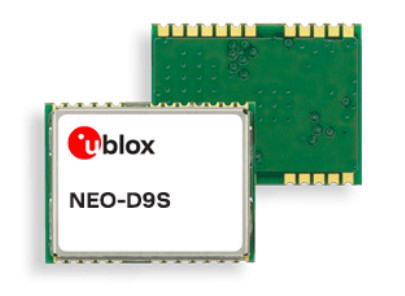u-blox' GNSS correction module for centimeter-level positioning
u-blox claims that its NEO-D9S module enhances GNSS data from a constellation of positioning satellites to provide accurate location positioning readings.
u-blox' NEO-D9S is a GNSS correction data receiver that receives Global Navigation Satellite System (GNSS) corrections from correction service providers.
The unit then combines these corrections with initial guidance data from the satellite constellation. This information is collected by a “rover (rover)” also mounted on the object being tracked.

The result is the ability to get more accurate position location readings than with GNSS signals alone.
What is the GNSS Correction Service?
The GNSS correction service sends data containing real-time information describing GNSS errors directly to a GNSS correction data receiver. One such GNSS correction data receiver is the NEO-D9S.
State Space Representation (SSR) is the latest iteration of the GNSS Correction Service. It models a large range of errors and transmits the data to the GNSS device.
The “rover (rover)” on the tracked object combines the correction data with signals received directly from GNSS to obtain very accurate results.

State Space Representation (SSR)
SSR corrections are distributed over IP and L-band (1525MHz to 1559MHz) satellite communication channels. These services can achieve centimeter-level positioning accuracy over large geographic areas.
Bandwidth requirements are low, and since all mobile GNSS receivers rely on the same GNSS correction data stream, SSR services may be inexpensive enough for mass-market applications.
Basic Operation of the GNSS Correction Module
The NEO-D9S contains a processor that decrypts the correction data from the GNSS correction service and provides it to a GNSS receiver, such as u-blox's ZED-F9P module.

The NEO-D9S module is used with a GNSS receiver (e.g. u-blox's ZED-F9P)
The device is initially configured to work with any correction service set to default. It can also be configured for use with any other L-band data broadcast. The configuration settings are stored in non-volatile memory (ROM).
To ensure high RF sensitivity and resistance to interference from neighboring channels, the NEO-D9S has an integrated SAW filter and TCXO.
Designed for automotive OEMs
L-band connectivity will free the NEO-D9S from the high cost and low reliability required for cellular connectivity.
As such, the device may be useful to automotive manufacturers and their Tier 1 OEMs. These areas will also serve device developers who need inexpensive but extremely accurate location information wherever they are traveling or even hiking throughout the African continent.
Safety Features
The NEO-D9S incorporates anti-spoofing algorithms. It also includes a signature mechanism to ensure secure firmware updates.
The module's anti-jamming capabilities include active CW detection and removal.
Physical Implementation Considerations
The device is powered by a 1.65V to 3.6V supply. At 3V, the average power consumption is 35mA.
Both the professional-grade NEO-D9S-00B and the automotive-grade NEO-DS9-00A can operate over the temperature range of -40°C to + 85°C. They are also RoHS (lead-free) and environmentally friendly (halogen-free).
The devices are available in a 24-pin lead-free chip carrier (LCC) package measuring 12.2mm x 16.0mm x 2.4mm and weighing 1.6 grams.
Support Tools
u-blox provides a C101-D9S application evaluation board for the NEO-D9S. There is also an application board C100-F9K for the ZED-F9K.
















